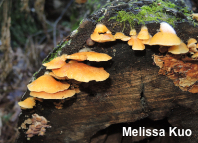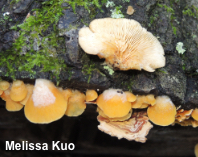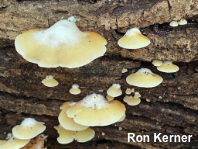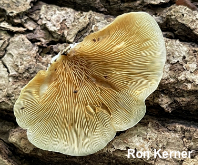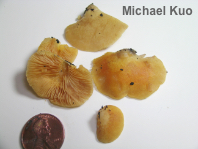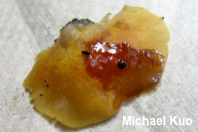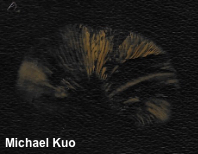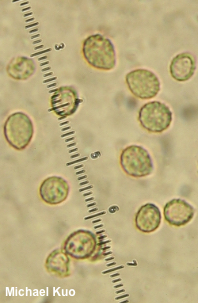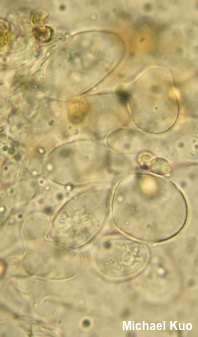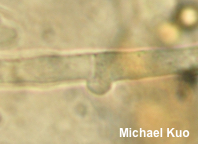| Major Groups > Gilled Mushrooms > Dark-Spored > Pleurotoid Mushrooms > Crepidotus > Crepidotus croceotinctus |

|
[ Basidiomycota > Agaricales > Inocybaceae > Crepidotus . . . ] Crepidotus croceotinctus by Michael Kuo, 28 February 2023 Crepidotus species all look the same to me, too. But this one has at least a few distinguishing features that can be assessed without unpacking your microscope: when fresh its cap is yellow and fairly bald; the young gills are yellow, and it appears on the deadwood of hardwoods east of the Great Plains. Ultimately, though, your identification of this mushroom will be facilitated through microscopic examination; the species has faintly punctate, egg-shaped spores, club-shaped cheilocystidia, and abundant clamp connections. "Crepidotus croceitinctus," with an i instead of an o, is considered an "orthographic variant" (an alternate spelling), which is the mycological world's way of gently accepting Peck's misspelling of his own species, a year after he first described it. Crepidotus subcroceitinctus, originally described on the basis of its putatively brighter yellow colors (Hesler & Smith 1965) is a synonym according to Bandala & Montoya (2000), representing the variability of the yellow shades present in the species. Thanks to Ron Kerner for collecting, documenting, and preserving Crepidotus croceotinctus for study; his collection is deposited in The Herbarium of Michael Kuo. Description: Ecology: Saprobic; growing alone or gregariously on the deadwood of oaks and other hardwoods; originally described from New York (Peck 1886); distributed in the Appalachians, the Midwest, and Mexico; also reported from South America. The illustrated and described collections are from Indiana and Kentucky. Cap: 1–3 cm across; semicircular or fan-shaped; bald or, with a lens, finely silky in places; dry; bright to pale yellow or orangish yellow overall, but often whitish and slightly fuzzy near the point of attachment; the margin faintly lined at maturity. Gills: Close; radiating; short-gills frequent; when young yellow to pale yellow; becoming dull brown with maturity. Stem: Absent. Flesh: Thin; watery yellowish; unchanging when sliced. Odor: not distinctive. Chemical Reactions: KOH on cap surface red. Spore Print: Medium brown. Microscopic Features: Spores 5–6 x 3.5–4.5 µm; ovoid or subellipsoid; finely roughened-punctate; faintly yellowish to brownish in KOH. Basidia 28–30 x 5–6 µm; 4-sterigmate or occasionally 2-sterigmate. Pleurocystidia not found. Cheilocystidia 25–42 x 5–17 µm; mostly clavate but also lageniform, inflated-cylindric, or nearly sphaeropedunculate; smooth; thin-walled; hyaline in KOH. Pileipellis a cutis; elements 3–10 µm wide, hyaline to yellow in KOH, smooth; exserted terminal cells cylindric with clavate to subcapitate or subfusiform apices. Clamp connections present. REFERENCES: C. H. Peck, 1886. (Murrill, 1917; Hesler & Smith, 1965; Senn-Irlet & de Meijer, 1998; Bandala & Montoya, 2000; Bandala & Montoya, 2004; Bandala & Montoya, 2008.) Herb. Kuo 10051504, 07222201. This site contains no information about the edibility or toxicity of mushrooms. |
© MushroomExpert.Com |
|
Cite this page as: Kuo, M. (2023, February). Crepidotus croceotinctus. Retrieved from the MushroomExpert.Com Web site: http://www.mushroomexpert.com/crepidotus_croceotinctus.html |
